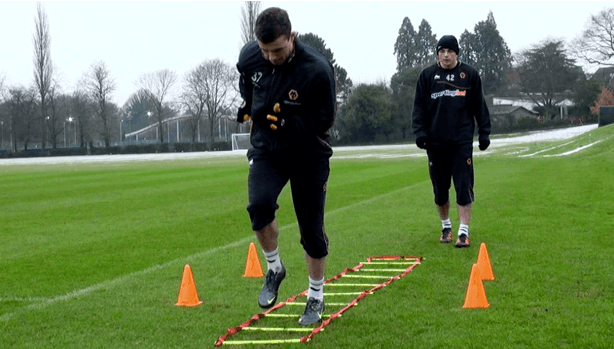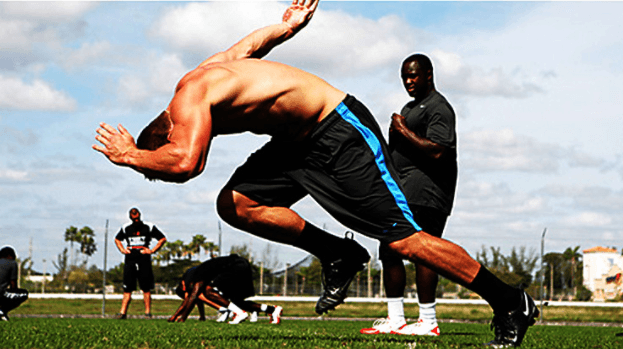Improve Athleticism With These 4 Reactive Agility Drills
Speed & AgilityABOUT THE AUTHOR

Danny Takacs
Danny Takacs is a strength and conditioning coach in Cincinnati, OH. He is the owner of Kratos Fitness, a private training facility that gets athletes into their prime physical condition. Danny holds a Master’s degree in Exercise Science from the California University of Pennsylvania and is a Certified Strength and Conditioning Specialist through the National Strength and Conditioning Association.
“We’ve all seen the endless ‘agility’ videos on Instagram and YouTube. They go something like this: an athlete performs the ‘Ickey shuffle’ through a speed ladder, then quickly transitions into a few figure 8’s around some strategically-placed cones. Next comes the salsa-dance-looking moves around a few more cones, and finally there’s a hop, skip, or a jump over a handful of perfectly-organized mini hurdles.”
— Coach Joe DeFranco on the terrible exercises that are passed off as agility training.
While cones, hurdles, and the like can serve a purpose, the majority of the exercises programmed with them are huge time-wasters. As an athlete, having finely tuned agility is necessary to competing at the highest level — regardless of your sport or position. Unfortunately, most agility training uses gimmicky equipment to fool athletes into thinking they are doing something productive.

// Real Agility
During competition, athletes have to react to a live stimulus. They must change their body’s position efficiently based on what is happening around them, in real-time. At no point during an athletic competition does your opponent tell you what they are going to do next and give you time to prepare for it. (Boy, would that make our job easy, right?)
So, doing endless repetitions of pre-programmed drills is not the most effective way of teaching an athlete agility, because everything they need to react to is laid out before them. They’ve done over and over, and they know all the movements. That’s where reactive agility drills come in.
Reactive agility drills throw an unpredictable stimulus at the athlete. This stimulus can be any visual or auditory cue, such as the pointing of a hand or blow of a whistle, which the athlete will need to respond to. Reactive agility exercises add a level of unpredictability, unseen in the standard, predetermined drills. This randomness replicates a true stimulus-response experience, better preparing athletes for actual competition.
Examples of reactive agility exercises are provided below, but keep in mind that there are unlimited variations you can create.

Your Title Goes Here
Your content goes here. Edit or remove this text inline or in the module Content settings. You can also style every aspect of this content in the module Design settings and even apply custom CSS to this text in the module Advanced settings.
1. Cat and Mouse Drill
The cat and mouse drill is simple and effective; one athlete acts as the mouse and the other acts as the cat. The “mouse” will initiate a chase and use their speed, agility, and advantage of determining the direction to get away. The “cat” will try to catch up by following the unpredictable movements. Be sure to alternate between roles. The distances and total volume can be programmed however you see fit.
2. Point and Move Drill
The point and move drill requires the athlete to stand in the center of a defined area. The coach will stand in front of the athlete and point in a direction for the athlete to move. The athlete will quickly shuffle or sprint in that direction and return to the center. Repeat for the desired number of repetitions.
4. Sport/Position-Specific Drill
You can get very specific to the athlete’s sport and position with reactive agility drills. While these may not be practical with a large number of athletes, they can work very well in small groups. Here’s an example of a football-specific drill for a running back:
3. Reactive Hip Turn Drill
For this drill, the athlete will begin by facing in the opposite direction of which he or she will be running. On cue, the athlete will quickly hip turn in the opposite direction and sprint for the desired distance. After sprinting, the athlete will decelerate and wait for the next cue. Be sure to perform the hip turn in both directions.
// Considerations
As you can see, these drills do not require a lot of equipment to implement, if any at all. They can also be modified to suit the needs of the coach (number of athletes, space available, etc.) and the individual athlete (sport, position, season, etc.). Simply change the stimulus and volume (sets, reps, distance) to match what you need.
Further, reactive agility exercises are backed by scientific research. For example, a recent study in The Journal of Australian Strength and Conditioning found that reactive agility tests can improve an athlete’s perception and response times (Inglis & Bird, 2016). Another study concluded that reactive and planned agility are two separate physical qualities, meaning that performing planned agility exercises may not improve reactive ability during competition (Lockie, Jeffriess, McGann, Callaghan,& Schultz, 2014).
// Conclusion
Reactive agility drills are an effective way of improving an athlete’s ability to efficiently change his or her body’s position in reaction to a live stimulus. Unlike planned agility drills, reactive exercises force athletes to respond to real-time cues just like they do during competition. Due to their effectiveness, applicability to competition, and ease of implementation, reactive agility drills should be a part of every strength and conditioning program.
References
Inglis, P., and Bird, S. P. (2016). Reactive Agility Tests: Review and Practical Applications. Journal of Australian Strength and Conditioning, 24 (5), 62-69.
Lockie, R., Jeffriess, M., McGann, T., Callaghan, S., and Schultz, A. (2014). Planned and Reactive Agility Performance in Semiprofessional and Amateur Basketball Players. International Journal of Sports Physiology and Performance, 9 (5), 766-771.
Are you a better coach after reading this?
More coaches and athletes than ever are reading the TrainHeroic blog, and it’s our mission to support them with useful training & coaching content. If you found this article useful, please take a momemnt to share it on social media, engage with the author, and link to this article on your own blog or any forums you post in.
Be Your Best,
TrainHeroic Content Team
HEROIC SOCIAL
HEROIC SOCIAL
TRAINING LAB
Access the latest articles, reviews, and case studies from the top strength and conditioning minds in the TH Training Lab

